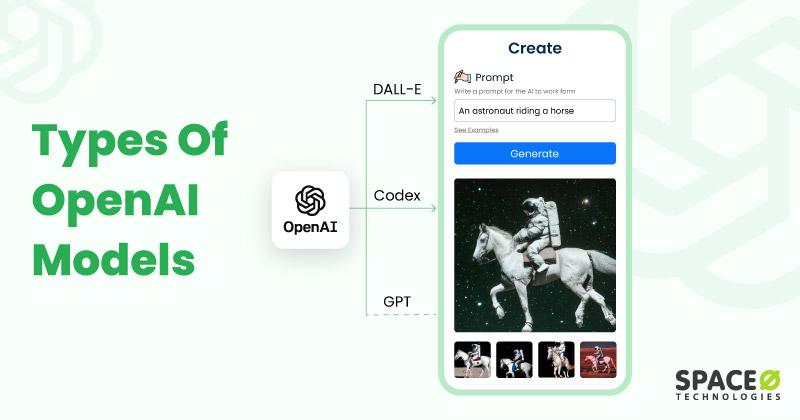

OpenAI is revolutionizing the world of artificial intelligence (AI) with its cutting-edge models that are capable of performing various tasks with remarkable accuracy and speed.
As per the paper published by OpenAI researchers, OpenAI’s GPT-3 has been ranked as the largest AI language model to date with over 175 billion parameters. Also, OpenAI has partnered with Microsoft to integrate its models into Microsoft’s cloud-based Azure AI services.
Considering OpenAI’s advancement in the field of AI, today we will explore the different types of OpenAI models that are making waves in the AI industry. From the popular GPT (Generative Pretrained Transformer) series to models like DALL·E and CLIP, we will delve into the workings and applications of each model.
So as an AI development company, we can explain to you different types of OpenAI models. So buckle up and get ready to dive into the world of OpenAI models!
Contents
| Model | Description | Applications |
|---|---|---|
| GPT | Generative Pretrained Transformer, a language model trained on a massive amount of data. | Text generation, question-answering, machine translation, and more. |
| GPT-2 | An updated version of GPT with additional training data and improved performance. | Same as GPT |
| GPT-3 | A generative model that creates unique images from textual descriptions. | Artistic creation, product design, and more |
| CLIP | A visual-linguistic model that can understand the relationships between images and text. | Image search, image captioning, and more |
| Codex | A model that generates code snippets based on natural language descriptions. | Software development, code generation, and more. |
| OpenAI Five | A machine learning model that plays the video game Dota 2. | Video game AI, reinforcement learning, and more. |
Note: The applications listed above are not exhaustive and may change as OpenAI continues to develop and improve their models.
The GPT series of models is the most popular and well-known set of models developed by OpenAI. The models in this series are language models that are capable of performing various language processing tasks, such as text generation, question-answering, and sentiment analysis.
The GPT series includes the following models:
The original GPT model was released in 2018 and had a capacity of 1.5 billion parameters. It was the first model to demonstrate the effectiveness of the Transformer architecture in language processing tasks.
This GPT-3 architecture is designed to generate text, providing a wide range of applications such as language translation, sentiment analysis, and content creation. GPT uses a deep neural network to analyze text data and generate new text based on that data.
The GPT-2 model was released in 2019 and had a capacity of 1.5 billion parameters. It demonstrated the ability of the Transformer architecture to generate coherent and grammatically correct text without fine-tuning.
It uses a larger neural network and more advanced algorithms to provide even more accurate text generation.
The latest and largest model in the GPT series, GPT-3 was released in 2020 and has a capacity of 175 billion parameters. It is the largest AI language model to date and has been ranked among the most powerful language models in the world.
GPT-3 is often used for content creation, language translation, and sentiment analysis, as well as more advanced applications such as image recognition and natural language processing.
Some of the use cases of the GPT series are
Find the Perfect OpenAI Solution for Your Business!
Let’s talk. We have experience in creating custom software solutions from scratch
DALL·E is an OpenAI model that generates images from textual descriptions. The model can generate images of anything, from an apple to a dinosaur, and can even create new and imaginative objects that don’t exist in reality.
This model uses deep learning algorithms to analyze text descriptions and generate images based on that data.
Some of the use cases of the DALL·E model are
CLIP is an OpenAI model that can perform a wide range of language processing tasks, such as image captioning, question-answering, and sentiment analysis. The model uses a combination of visual and textual information to perform its tasks and can even generate creative captions for images.
Some of the use cases of the CLIP model are
Codex is an OpenAI model that can generate code snippets based on natural language descriptions. The model can generate code in multiple programming languages and can even write complete programs based on a high-level description.
Some of the use cases of the Codex model are
OpenAI Five is a team of five OpenAI models that can play the game Dota 2 at an extremely high level. The models are capable of learning from their past experiences and can adapt to new situations in real-time.
Some of the use cases of the OpenAI Five model are
Looking for other OpenAI alternatives? Visit our resource center for a complete overview of OpenAI and the other AI tools available.
Want to Hire OpenAI Software Developers?
Get in touch with us. We have skilled OpenAI software developers who can provide OpenAI API services as per your business requirements.
OpenAI models are important in AI research as they represent state-of-the-art technology in the field of natural language processing (NLP) and machine learning.
OpenAI models such as GPT-3 have demonstrated remarkable performance in various language tasks, such as language translation, text summarization, and question-answering.
Their success has encouraged further research in the field of NLP, leading to new developments and breakthroughs.
OpenAI models are available to the general public through its API, which provides access to its models for a fee.
However, OpenAI has also made its models available for research purposes, providing access to academic institutions and researchers for non-commercial projects.
Like any AI technology, OpenAI models have certain limitations. For example,
Yes, OpenAI models can be customized for specific applications by fine-tuning them on a specific task or dataset.
This involves retraining the model on a smaller dataset that is specific to the task at hand, allowing the model to adapt to the specific requirements of the application.
OpenAI has implemented various measures to ensure the security of its models and prevent malicious attacks or misuse. For example,
In conclusion, OpenAI has revolutionized the field of AI with its cutting-edge models that can perform a wide range of tasks. From language generation to image processing, OpenAI models have shown immense potential for transforming industries and solving real-world problems.
GPT, GPT-2, and GPT-3 are three of the most prominent OpenAI models that have been widely adopted in the AI industry. These models are capable of performing natural language processing and understanding tasks, making them ideal for chatbots, virtual assistants, and language translation.
Other OpenAI models, such as DALL·E, CLIP, Codex, and OpenAI Five, are equally impressive and have their own unique applications in image generation, understanding, and gaming.
All in all, the future of OpenAI models looks bright, and we can expect to see further advancements in the field in the coming years.
If you’re interested in learning more about OpenAI and its capabilities, consider reaching out to an OpenAI app development agency for a complete overview.
What to read next